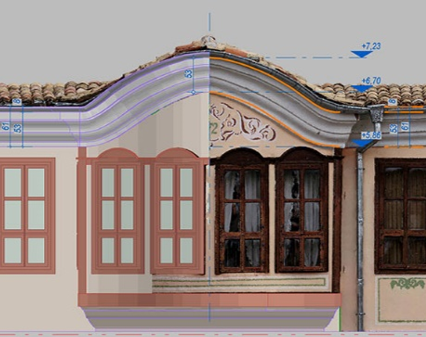Digital three-dimensional architectural survey of traditional Bulgarian houses – architectural BIM from point cloud survey data
DOI:
https://doi.org/10.14568/cp2019027Keywords:
BIM, ArchiCAD, Cultural Heritage, Traditional Houses, Reconstruction, Virtual PresentationAbstract
Nowadays the technology is often ahead of its implementation in the practice. Two novel technologies have affected the field of conservation and documentation of cultural and historic heritage and await their proper mutual integration. They are the 3D photogrammetric surveying and the Building Information Modelling (BIM). This research proposes a methodology for producing a complete and precise 3D Building Information Model from a point cloud, obtained via a 3D photogrammetric survey. An existing traditional house in Bulgaria is used as a case study. The aims were to optimise the process and to minimise the large number of software, used in the conventional workflow. They were achieved using only one application – ArchiCAD version 22. The complete BIM was later used for producing 3D artistic visualisations and for an interactive 3D web presentation. This paper describes the methodology and the software needed, discussing the techniques and the results.
Received: 2019-8-12
Revised: 2019-12-27
Accepted: 2020-5-6
Online: 2020-7-8
Publication: 2021-2-10
Downloads
References
[1] Georgiev, G., ‘Digitalization of Bulgarian cultural heritage’, Journal of Economic Development, Environment and People, 8(1) (2018) 6-17, https://dx.doi.org/10.26458/jedep.v8i1.606.
[2] Murphy, M., McGovern, E., Pavia, S., ‘Historic building information modelling (HBIM)’, Structural Survey, 27 (2009) 311-327, https://doi.org/10.1108/02630800910985108.
[3] Daskalova-Ivanova, T., ‘Rehabilitation of local architectural and structural technologies from the “Central Balkan” region and their application in the architectural education’, Tangible and intangible heritage in civil engineering, Faber, Veliko Tarnovo, (2019) 107-115.
[4] Apollonio, F. I.; Gaiani, M.; Sun, Z., ‘A reality integrated BIM for architectural heritage conservation’, in Handbook of Research on Emerging Technologies for Architectural and Archaeological Heritage, IGI Global, (2017) 31-65, https://doi.org/10.4018/978-1-5225-0675-1.ch002.
[5] Dore, C.; Murphy, M., ‘Historic building information modelling (HBIM)’, in Handbook of Research on Emerging Digital Tools for Architectural Surveying, Modeling, and Representation, IGI Global, (2015) 233-273, https://doi.org/10.4018/978-1-4666-8379-2.ch007.
[6] Ivanov, K., ‘Digital three-dimensional architectural survey of traditional Bulgarian houses – software interoperability and data conversion’/‘Цифрово тримерно архитектурно заснемане на традиционни български къщи – взаимодействие и превръщане на данни между софтуеъра’, Collection of Scientific Publications, New Bulgarian University, Sofia, 5 (2017-18) 19-29.
[7] Angelova, R., Shumenski Vazrozhdenski Kasti/Шуменски възрожденски къщи, Bulgarian Academy of Science, Sofia (1965).
[8] Stefanov, K., ‘3D documentation of selected examples of Bulgarian traditional residential architecture’, manuscript, (2019).
[9] Logothetis, S.; Delinasiou, A.; Stylianidis, E., ‘Building information modelling for cultural heritage: a review’, in ISPRS Annals of the Photogrammetry, Remote Sensing and Spatial Information Sciences, II-5/W3 (2015) 177-183, https://doi.org/10.5194/isprsannals-II-5-W3-177-2015.
[10] Oreni, D.; Karimib, G.; Barazzettia, L., ‘Applying BIM to built heritage with complex shapes: The Ice house of Filarete’s Ospedale Maggiore in Milan, Italy’, in The International Archives of the Photogrammetry, Remote Sensing and Spatial Information Sciences, XLII-2/W5 (2017) 553-560, https://doi.org/10.5194/isprs-archives-XLII-2-W5-553-2017.
[11] Richens, P.; Herdt, G., ‘Modelling the Ionic capital’, in Computation: The New Realm of Architectural Design, ed. G. Cagdas & B. Colakoglu, eCAADe, Istanbul (2009) 809-816.
[12] Tommasi, C.; Achille; C., Fassi, F., ‘From point cloud to BIM: A modelling challenge in the cultural heritage field’, in The International Archives of the Photogrammetry, Remote Sensing and Spatial Information Sciences, XLI-B5 (2016) 429-436, https://doi.org/10.5194/isprsarchives-XLI-B5-429-2016.
[13] Bolognesi, C. M.; Fiorillo, F., ‘The integration of 3D survey technologies for an accurate reality-based representation: From data acquisition to BIM modeling’, in Conservation, Restoration, and Analysis of Architectural and Archaeological Heritage, IGI Global, (2019) 321-345, https://doi.org/10.4018/978-1-5225-7555-9.ch013.
[14] Palestini, C.; Basso, A.; Graziani, L., ‘Integrated photogrammetric survey and BIM modelling for the protection of school heritage, applications on a case study’, in The International Archives of the Photogrammetry, Remote Sensing and Spatial Information Sciences, XLII-2 (2018) 821-828, https://doi.org/10.5194/isprs-archives-XLII-2-821-2018.
[15] Brusaporci, S. (ed.), Handbook of Research on Emerging Digital Tools for Architectural Surveying, Modeling, and Representation, IGI Global (2015).

Downloads
Published
How to Cite
Issue
Section
Categories
License
This work is distributed under a Creative Commons Attribution License (CC BY-NC-ND 4.0) which permits use, distribution, and reproduction in any medium following no commercial or derivatives, provided the original author and source are credited.
Copyright remains with the authors.






